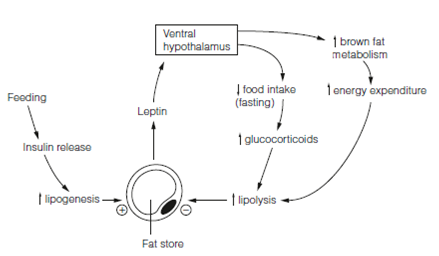Short-term satiety signals
Satiety signals may be humoral or neural in Figure Cholecystokinin (CCK) is secreted by the gut in response to food. As a circulating gut hormone it acts at the area postrema. As a local hormone it acts on gut vagal afferents that project to the NST. CCK also inhibits feeding by acting as a transmitter in hypothalamic anorexigenic pathways. Somatostatin and peptide YY are also gut hormone satiety signals.
Afferent input from taste buds and pharynx, stomach distension, and neural signals related to energy metabolism from the liver all inhibit eating. A Stretch receptor afferents conveying gastric distension signals from the gut run in the vagus nerve to the NST. The inhibition of food intake by CCK and gastric distention is mediated by the paraventricular nucleus (PVN) of the hypothalamus which receives input from the NST.

Figure: Negative feedback control of fat stores by leptin. An increase in the size of the fat store causes a rise in leptin release. This activates processes which result in increased fat breakdown.